13 Water Pollution Facts and Statistics in Canada: 2025 Update
-
Chantelle Fowler
- Last updated:
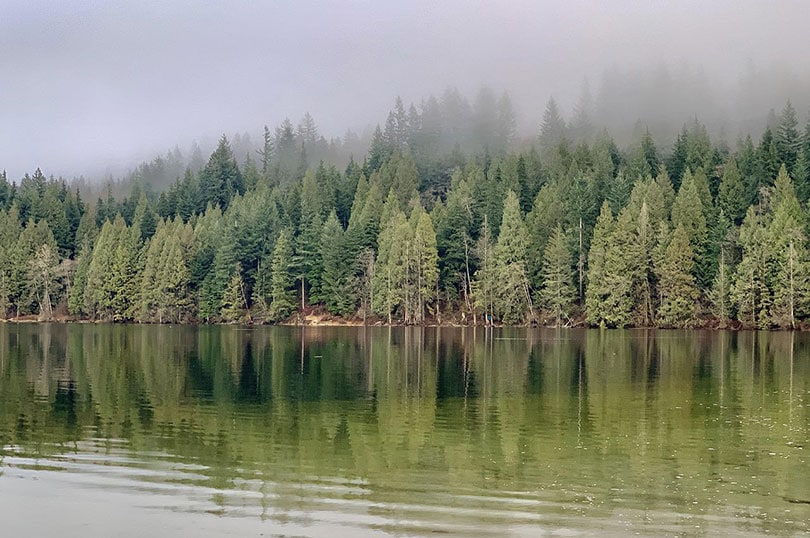
Note: This article’s statistics come from third-party sources and do not represent the opinions of this website.
Canada is a country richly endowed with water. It has one of the world’s largest renewable freshwater supplies and about 20% of the world’s surface freshwater. While most of the country has access to clean and fresh water, that doesn’t mean there are not issues with water pollution in Canada.
Polluted waterways are caused by sewage, runoff, industrial pollution and waste, and poor water infrastructure.
Click below to jump ahead:
- Water Pollution on Canada’s Reserves
- What’s In Canada’s Water
- The Effects of Water Pollution in Canada
The 13 Water Pollution Statistics in Canada
- There are 30 long-term drinking water advisories in 26 communities on reserves.
- The Neskantaga First Nation has been under a boil water advisory for 27 years.
- People living on reserves are 90 times more likely to have no access to running water than other Canadians.
- In 2017, over 270 million cubic meters of raw sewage and stormwater leaked into bodies of water across Canada.
- Three billion barrels worth of Alberta bitumen has entered the world’s ocean
- Two hundred billion liters of untreated sewage are discharged annually into Canada’s waters.
- Between 1970 and 2017, freshwater-dependent wildlife declined by 14% on the Pacific coast.
- 11.7% of freshwater species in Canada are considered to be at risk.
- Many of Ontario’s 31,000 lakes have a pH value of 5, making them dangerous for fish and plants.
- Fish exposed to pharmaceutical and artificial contaminants must work 30% harder to survive.
- 50% of salmon exposed to diluted bitumen die within 2 months of exposure.
- Nearly 22 million pounds of plastic debris end up in the Great Lakes every year.
- Plastic is responsible for 80% of the litter found on the Great Lakes shorelines.
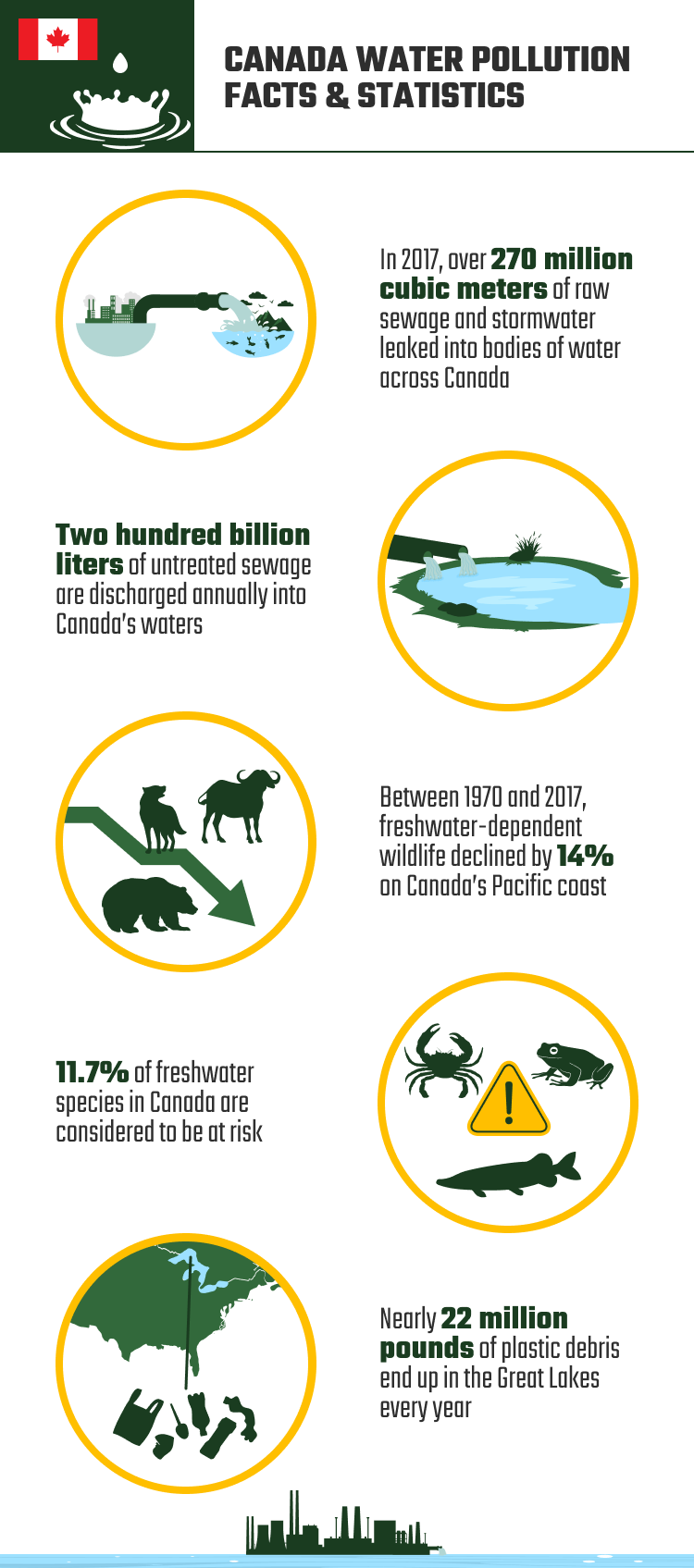
Water Pollution on Canada’s Reserves
1. There are 30 long-term drinking water advisories in 26 communities on reserves
(Government of Canada)
At the time of writing, 30 long-term drinking water advisories are in effect in 26 reserve communities. A drinking water advisory is long-term once it has been in place for over a year. The primary reason for these advisories is due to disinfection, equipment malfunction, and source water quality. Though this number is still high, 137 long-term drinking water advisories have been lifted over the last seven years, so progress is being made.
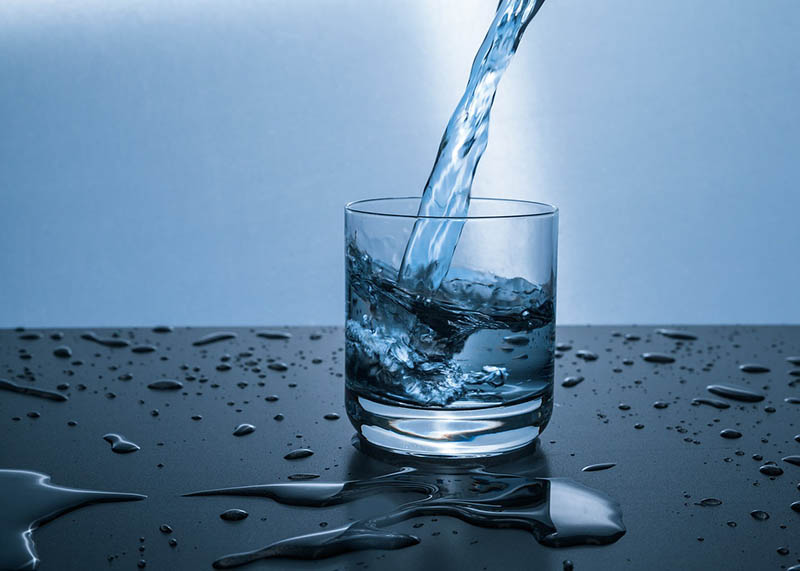
2. The Neskantaga First Nation has been under a boil water advisory for 27 years
(News Wire)
Many First Nations communities have been without clean water for years. For example, the Neskantaga First Nation, north of Thunder Bay, Ontario, has had its boil water advisory in effect since February 1, 1995. This community is home to 374 people, and the boil water advisory currently affects 76 households and six community buildings.
The federal government paid for a new water treatment plant in the early 1990s for the community, but it was ineffective almost immediately. Several recent attempts have been made to upgrade the reserve’s water plant, but every attempt has failed.
3. People living on reserves are 90 times more likely to have no access to running water than other Canadians
(Morrison et al.)
Access to safe drinking water is an ongoing problem for people living on reserves throughout Canada. Those on reserves are 90 times more likely to have no access to running water. In addition, many people still don’t have indoor plumbing and need to use outhouses or slop pails. The water comes from communal standpipes or is delivered to each house by truck. And even when water is available, it is often poorly treated or compromised by corroded piping.

What’s In Canada’s Water
4. In 2017, over 270 million cubic meters of raw sewage and stormwater leaked into bodies of water across Canada
(Statistics Canada)
While most wastewater is treated before getting discharged, the volume of untreated sewage from sewer outflows and systems without treatment reached 270 million cubic meters in 2017. This is roughly equivalent to one day of water flowing over Niagara Falls. Every province, aside from Prince Edward Island, Saskatchewan, and Yukon. This raw sewage spewed into Canada’s rivers and oceans.
5. Three billion barrels worth of Alberta bitumen has entered the world’s ocean
(Canada’s National Observer)
Bitumen is an extra-heavy crude oil that’s found in natural deposits in Alberta’s oilsands. Over 12 million barrels of bitumen have been pulled out of the ground in Alberta since 1967. Of these 12 million barrels, 5.6 billion wind up in our atmosphere, 3.7 billion go to the plants, and another 3.7 billion wind up in our oceans.
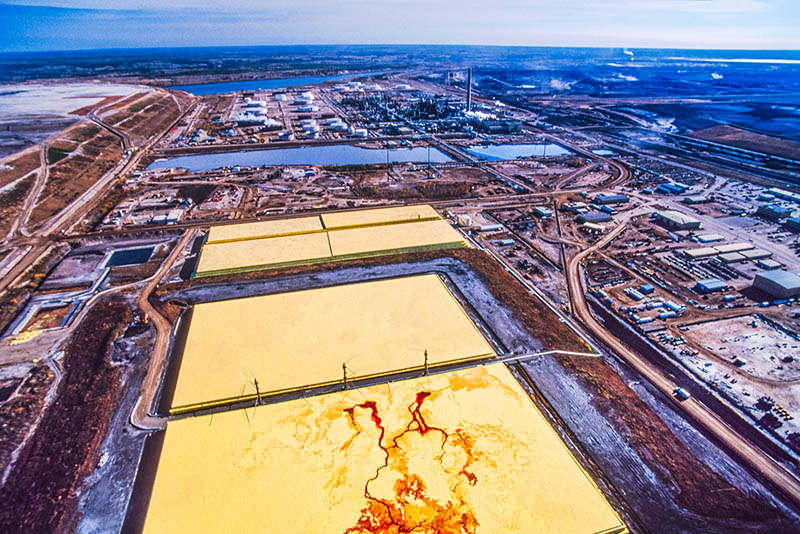
6. Over 200 billion liters of untreated sewage are discharged annually into Canada’s waters
(The Province)
Between 2013 and 2018, 200 billion liters of untreated sewage was released into Canada’s water each year, resulting in one trillion liters of leaked sewage over those five years. The most significant contributor to this nationwide problem is the province of British Columbia, where municipalities reported leaking or spilling 77 billion liters of raw sewage in 2017. Unfortunately, these numbers are likely much less than the actual amount of sewage being leaked. Environment Canada doesn’t report each spill to the public, and many cities do not do it themselves.
 The Effects of Water Pollution in Canada
The Effects of Water Pollution in Canada
7. Between 1970 and 2017, freshwater-dependent wildlife declined by 14% on the Pacific coast
(WWF Canada)
Canada’s waterways face significant threats from pollution, habitat loss, and overuse that affect the health of the watersheds and wildlife that depend on them. For example, freshwater-dependent wildlife declined by 14% on the Pacific coast between 1970 and 2017. Yet, despite the clear wildlife decline, these habitats are still unprotected and understudied.
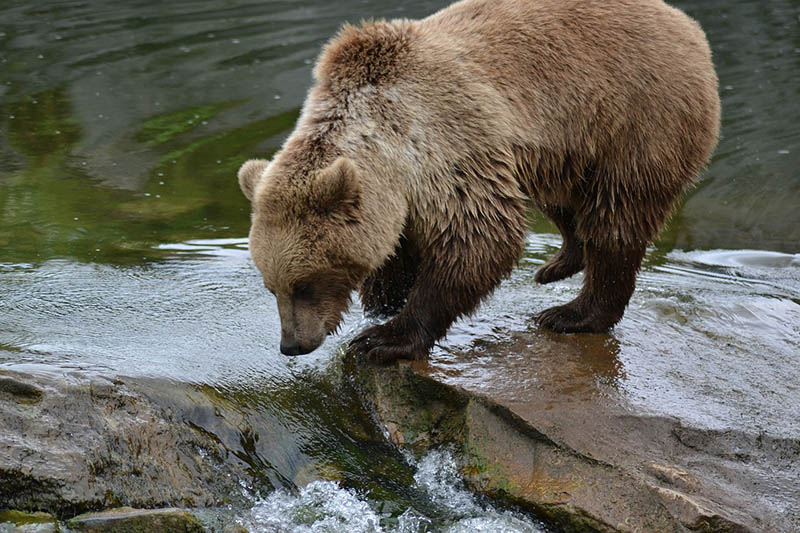
8. 7% of freshwater species in Canada are at risk
(Deforges et al.)
A study from 2021 looked at the conversation status of freshwater species throughout Canada. They focused primarily on organisms that rely on freshwater, such as invertebrates, fishes, aquatic plants, mammals, and birds. The study found that 11.7% of freshwater plants and animals are “at risk” – either threatened, endangered, or extirpated. Threats like pollution, habitat degradation, invasive species, and climate change impair Canada’s freshwater ecosystems, resulting in rapid biodiversity loss.
9. Many of Ontario’s 31,000 lakes have a pH value of 5, making them dangerous for fish and plants
(Nature)
Acid rain, precipitation with acidic components, can change the H level of lakes, harming fish and wildlife. A lake is in serious condition when its pH value rises above or falls below 5.5, the level at which some organisms that fish feed on can no longer survive. Many of Ontario’s 31,000 lakes have a pH value of 5, making them highly acidic for fish and plants. When pH levels approach 5, non-desirable plankton species and moss may invade the waters, while fish populations slowly disappear. In addition, the bottom can get covered in undecayed materials and mosses can start dominating the shores.
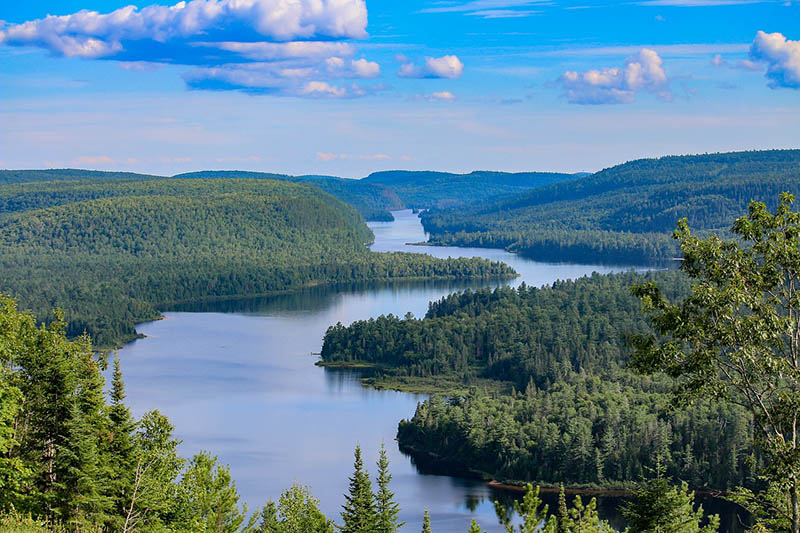
10. Fish exposed to pharmaceutical and artificial contaminants must work 30% harder to survive
(CBC News)
Pharmaceuticals and artificial contaminants make it difficult for fish in Hamilton, Ontario to survive. A recent study shows that when fish are exposed to high levels of pollutants in the water, they burn more energy that would otherwise go toward their vital functions. As a result, the fish exposed to contaminants need to work 30% harder than others to survive. This results in less available energy to support other functions like swimming around and interacting with other fish. This can affect their reproduction and territories as they won’t have the energy to reproduce or defend their territory.
11. 50% of salmon exposed to diluted bitumen die within 2 months of exposure.
(Alderman et al.)
A study from 2018 suggests that 50% of sockeye salmon exposed to diluted bitumen died within the first 60 days of exposure. The fish which survived the exposure showed changes in brain development and performance levels.
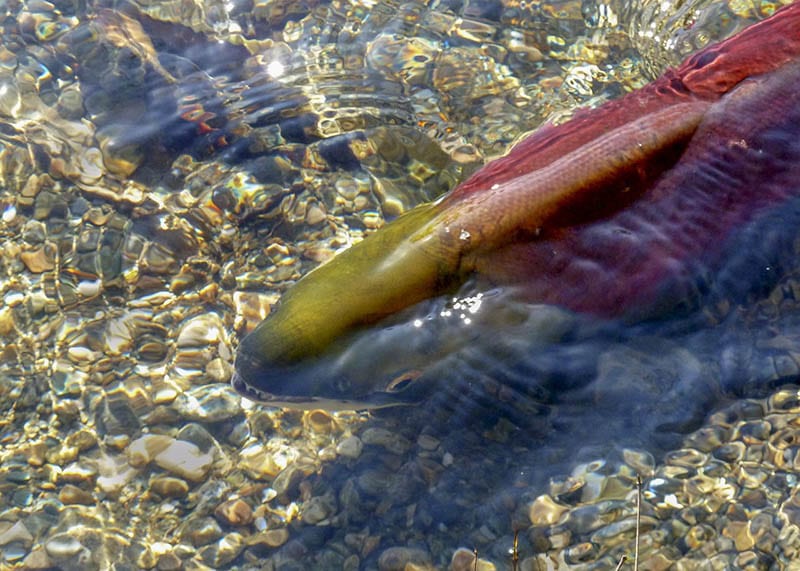
12. Nearly 22 million pounds of plastic debris end up in the Great Lakes every year
(Hoffman et al.)
Researchers found that almost 22 million pounds of plastic debris find its way into the Great Lakes from the U.S. and Canada every year. Approximately half of the plastic pollution—5,000 metric tons—in the Great Lakes goes into Lake Michigan annually. The plastic pollution in Lake Michigan is the equivalent of 100 Olympic-sized swimming pools of plastic bottles.
13. Plastic is responsible for 80% of the litter found on the Great Lakes shorelines
(RIT)
Unlike the patches of floating garbage, you’d find in the ocean, pollution on the Great Lakes winds up on the shore. Plastic accounts for 80% of the litter on the shorelines of the Great Lakes. Dense plastic like microbeads and Styrofoam tends to sink and may get consumed by wildlife, thereby entering the food chain.
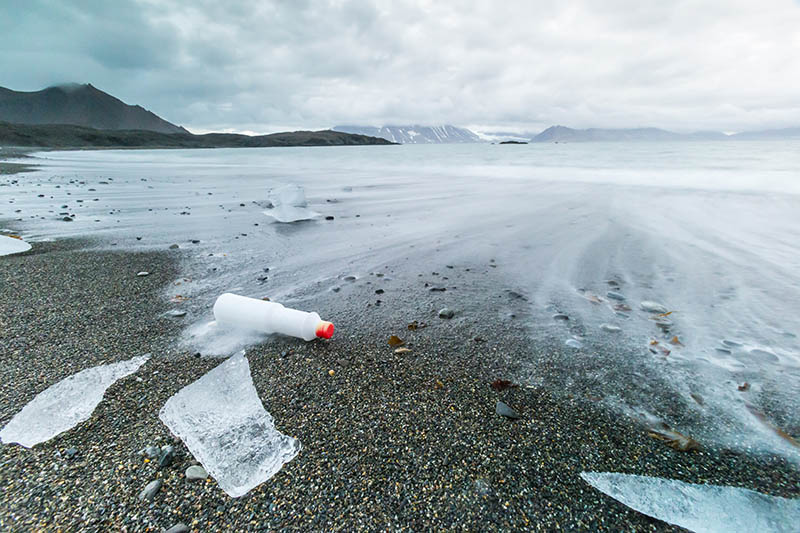
Frequently Asked Questions About Water Pollution Statistics in Canada
What are drinking water advisories?
A drinking water advisory (DWA is a preventative measure that’s put into effect to protect the public when there is a potential for contaminants in the water. DWAs are put into one of three categories depending on the severity:
- Boil water advisory. Water is okay to drink once it’s been boiled. However, the water must come to a rolling boil for at least one minute before it’s drinkable or usable for other purposes like feeding pets, making infant formula, or brushing teeth.
- Do not consume advisory: Water is not fit to consume. These advisories are issued when the water system has contaminants like lead that can’t be removed by boiling. This water should not be used in any consumable capacity (e.g., cooking, drinking, teeth brushing), or bathing for populations that may accidentally swallow the water (e.g., infants, elderly).
- Do not use advisory: Water cannot be consumed or used. These advisories warn that the public should not use the water in any capacity as doing so will pose a health risk. This means the water system contains pollutants that cannot be removed via boiling and can cause irritation to the skin, eyes, and nose.
How does pollution get into the water in Canada?
Pollution can enter Canadian waterways in many ways, including runoff, spills, and the deposition of airborne pollutants. Sometimes people think that disposing of waste in their local waterways is an easy way to get rid of garbage. However, it will never disappear whether they’re tossing large or small amounts of waste. It may get carried away by currents, giving the illusion that it’s vanished and may appear downstream in a changed form, but it doesn’t go away.
What are the largest bodies of water in the country?
The rivers and lakes north of 60 degrees latitude are some of Canada’s largest. The Mackenzie River is the country’s largest river at 4,000 kilometers long. It covers part of five provinces and territories, including B.C., Alberta, Saskatchewan, Yukon, and Northwest Territories. Lake Superior is one of the biggest bodies of fresh water on Earth. It contains more water than the other Great Lakes combined.
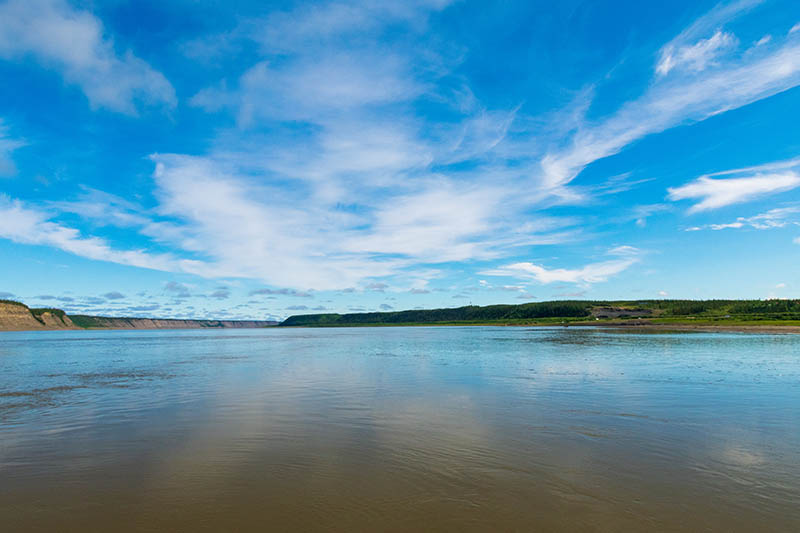
What are some of the country’s most notable water pollution incidents?
Between 1962 and 1970, a pulp and paper operation in northwest Ontario discharged between 22,000 and 24,000 pounds of mercury from their plant in the nearby Wabigoon river. The contamination affected fish downstream, and the Indigenous Anishinaabe community of Grassy Narrows First Nation is still affected by this disaster.
In 2000, E. coli and Campylobacter jejuni bacteria contaminated the drinking water supply of Walkerton, Ontario, resulting in the Walkerton E. coli outbreak. The contamination occurred due to improper water treatment after a particularly heavy rainfall between April and May. This rainfall drew bacteria from nearby manure into the aquifer of a well nearby. The outbreak resulted in 2,300 people getting ill and seven dying.
What is Canada doing about the Great Lakes water pollution situation?
The Great Lakes account for 18% of Earth’s fresh surface water. In the 1970s, Lake Erie was pronounced “dead” due to industrial waste and sewage from runoffs. Between the 1970s and 1990s, Ontario worked hard to restore the Lakes by cleaning up polluted waterfronts and reducing the toxic chemicals harming the wildlife.
In 2012, the U.S. and Canada signed an amended version of the Great Lakes Water Quality Agreement to restore and maintain the physical, chemical, and biological integrity of the ecosystem of the Great Lakes Basin. The amended version addresses invasive species, habitat degradation, and how climate change affects the lakes. It also supports continuing the work to explore harmful algae, chemicals, and vessel discharge.
Conclusion
Canada may be one of the most developed countries in the world, but it still has issues with water pollution and water supply. Though most Canadians have reliable access to fresh and clean water, there’s no denying that the country has alienated a fair portion of its population by not providing them with the water access they deserve. There’s also no denying that industrial and municipal discharge, runoffs, spills, and airborne pollutants have infiltrated one of the country’s most essential and abundant natural resources.
Featured Image Credit: Warp1, Pixabay
Contents

